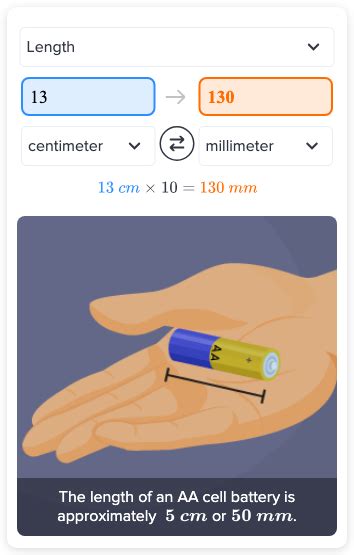How Many Mm Is 13 Cm
Kalali
Mar 21, 2025 · 4 min read

Table of Contents
How Many mm is 13 cm? A Comprehensive Guide to Metric Conversions
Understanding metric conversions is crucial in various fields, from everyday life to scientific research. This comprehensive guide will delve deep into the conversion of centimeters (cm) to millimeters (mm), specifically focusing on how many millimeters are in 13 centimeters. We'll explore the underlying principles, provide step-by-step calculations, and offer practical applications to solidify your understanding.
Understanding the Metric System
The metric system, also known as the International System of Units (SI), is a decimal system based on powers of 10. This makes conversions incredibly straightforward compared to systems like the imperial system (inches, feet, yards, etc.). The core units are meters (m) for length, kilograms (kg) for mass, and liters (L) for volume. All other units are derived from these base units.
For length, we have the following common units, ordered from largest to smallest:
- Kilometers (km): 1 km = 1000 m
- Meters (m): The base unit of length.
- Decimeters (dm): 1 m = 10 dm
- Centimeters (cm): 1 m = 100 cm
- Millimeters (mm): 1 m = 1000 mm
The Relationship Between Centimeters and Millimeters
The key to understanding the conversion between centimeters and millimeters lies in their relationship to the meter. Since 1 meter equals 100 centimeters and 1000 millimeters, we can establish a direct relationship:
- 1 cm = 10 mm
This means that one centimeter is equal to ten millimeters. This simple conversion factor is the foundation for all our calculations.
Calculating Millimeters in 13 Centimeters
Now, let's tackle the main question: how many millimeters are in 13 centimeters? Using the conversion factor we established (1 cm = 10 mm), the calculation is simple:
13 cm * 10 mm/cm = 130 mm
Therefore, there are 130 millimeters in 13 centimeters.
Practical Applications and Real-World Examples
Understanding this conversion is vital in numerous scenarios:
-
Engineering and Design: Precise measurements are paramount in engineering and design. Converting between centimeters and millimeters is essential for creating accurate blueprints, technical drawings, and manufacturing specifications. Imagine designing a circuit board – the dimensions need to be precise down to the millimeter.
-
Construction and Building: Similarly, construction projects rely heavily on accurate measurements. From laying bricks to installing plumbing, knowing how to convert between cm and mm ensures the project is built according to specifications and avoids costly errors. Think of the precise measurements needed for window frames or tile installations.
-
Medicine and Healthcare: In medicine, precise measurements are crucial for administering medication, diagnosing conditions, and performing surgeries. Many medical instruments and devices use millimeter scales for accurate readings.
-
Everyday Life: Even in everyday life, understanding metric conversions can be useful. For example, measuring the length of an object, determining the dimensions of a piece of furniture, or following a recipe that requires precise ingredient measurements.
-
Scientific Research: In various scientific disciplines, accurate measurements are essential for experimental accuracy and data reliability. Conversion between cm and mm is commonplace in fields like physics, chemistry, and biology.
-
3D Printing and Modeling: The world of 3D printing and 3D modeling relies heavily on precise measurements. Designing and printing objects requires a clear understanding of units, including the relationship between cm and mm.
-
Photography and Videography: In photography and videography, understanding sensor sizes (often expressed in millimeters) and focal lengths (often expressed in millimeters) is crucial for achieving the desired depth of field and image composition.
Beyond 13 cm: Mastering Metric Conversions
The principle behind converting 13 cm to mm applies to any centimeter value. To convert any number of centimeters to millimeters, simply multiply the number of centimeters by 10.
Here are a few examples:
- 5 cm: 5 cm * 10 mm/cm = 50 mm
- 25 cm: 25 cm * 10 mm/cm = 250 mm
- 150 cm: 150 cm * 10 mm/cm = 1500 mm
- 0.5 cm: 0.5 cm * 10 mm/cm = 5 mm
Converting Millimeters to Centimeters
The reverse conversion (millimeters to centimeters) is equally straightforward. Divide the number of millimeters by 10 to obtain the equivalent in centimeters:
- 100 mm: 100 mm / 10 mm/cm = 10 cm
- 20 mm: 20 mm / 10 mm/cm = 2 cm
- 500 mm: 500 mm / 10 mm/cm = 50 cm
Avoiding Common Mistakes
While the conversion itself is simple, common mistakes can arise:
- Incorrect multiplication or division: Double-check your calculations to avoid simple mathematical errors.
- Unit confusion: Always clearly identify the units you're working with (cm vs. mm) to avoid misinterpretations.
- Decimal point errors: Be careful when dealing with decimal values.
Conclusion: Mastering the Fundamentals of Metric Conversions
The conversion of 13 centimeters to millimeters, and more broadly, understanding metric conversions, is a fundamental skill with widespread applications. By mastering the simple principle of multiplying centimeters by 10 to get millimeters, you'll be equipped to handle various measurement tasks with accuracy and confidence across diverse fields. Remember to practice regularly and solidify your understanding of the metric system to enhance your problem-solving abilities in various aspects of life and work. This understanding will undoubtedly prove invaluable as you navigate tasks requiring precise measurements and calculations.
Latest Posts
Latest Posts
-
How Many Ounces Of Sour Cream Are In A Cup
Mar 28, 2025
-
Does A Catfish Have A Backbone
Mar 28, 2025
-
How Many Feet Are In 42 Inches
Mar 28, 2025
-
How Many Acres Is A Square Mile
Mar 28, 2025
-
15 Out Of 50 As A Percentage
Mar 28, 2025
Related Post
Thank you for visiting our website which covers about How Many Mm Is 13 Cm . We hope the information provided has been useful to you. Feel free to contact us if you have any questions or need further assistance. See you next time and don't miss to bookmark.
